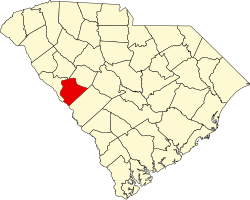Edgefield County | |
|---|---|
 Edgefield County Courthouse | |
| Nickname: Home of Ten Governors | |
| Motto: "It Feels Different Here Because It Is Different Here" | |
 Location within the U.S. state of South Carolina | |
 South Carolina's location within the U.S. | |
| Coordinates: 33°47′N81°58′W / 33.78°N 81.97°W | |
| Country | |
| State | |
| Founded | 1785 |
| Named after | County's location at the Edge of the State [1] |
| Seat | Edgefield |
| Largest community | Edgefield |
| Area | |
• Total | 507.00 sq mi (1,313.1 km2) |
| • Land | 500.71 sq mi (1,296.8 km2) |
| • Water | 6.29 sq mi (16.3 km2) 1.24% |
| Population (2020) | |
• Total | 25,657 |
• Estimate (2024) | 29,455 |
| • Density | 51.241/sq mi (19.784/km2) |
| Time zone | UTC−5 (Eastern) |
| • Summer (DST) | UTC−4 (EDT) |
| Congressional district | 3rd |
| Website | edgefieldcounty |
Edgefield County is a county located on the western border of the U.S. state of South Carolina. As of the 2020 census, its population was 25,657. [2] Its county seat and largest community is Edgefield. [3] The county was established on March 12, 1785. [4] The Savannah River makes up part of the western border of Edgefield County; across the river lies the city of Augusta, Georgia. Edgefield is part of the Augusta-Richmond County, GA-SC Metropolitan Statistical Area.
Contents
- History
- Geography
- National protected area
- State and local protected area
- Major water bodies
- Adjacent counties
- Major highways
- Major infrastructure
- Demographics
- 2020 census
- 2010 census
- 2000 census
- Government and politics
- Economy
- Media
- Communities
- City
- Towns
- Census-designated place
- Education
- Notable people
- Governors
- Other notable people
- See also
- References
- Further reading
- External links


